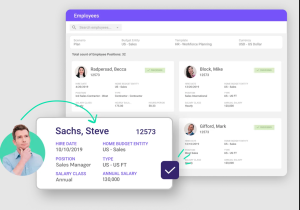Meet Planful’s Analyst Assistant — your trusted AI-powered partner for finance, always ready for you.
Learn moreStrategic Workforce Planning
Strategic Workforce Planning Definition
Workforce planning is an essential process for organizations aiming to align their talent strategies with business objectives. While many businesses focus on short-term hiring needs, strategic workforce planning takes a forward-thinking approach, ensuring the right people are in place to drive long-term success.
By leveraging strategic workforce planning tools and methodologies, businesses can anticipate workforce trends, mitigate risks, and make data-driven decisions about talent acquisition, retention, and development. This guide explores the importance of strategic workforce planning, its benefits, and best practices for implementation.
Strategic Workforce Planning FAQs
What is Strategic Workforce Planning?
Strategic workforce planning is the process of aligning a workforce with an organization’s long-term business goals. It involves forecasting future talent needs, analyzing workforce data, and creating strategies to bridge skill gaps.
Unlike operational workforce planning, which focuses on short-term staffing and scheduling, strategic workforce planning solutions are designed to support long-term objectives. These solutions include strategic workforce planning software that integrates data analytics, scenario modeling, and workforce optimization techniques.

Strategic Workforce Planning Dashboard
Objectives of Strategic Workforce Planning
The objectives of strategic workforce planning include:
- Identifying critical roles and skills required for future growth
- Addressing talent shortages and succession planning
- Enhancing workforce agility and adaptability
- Aligning HR, finance, and leadership strategies. (Aligning Finance and HR ebook)
- Reducing hiring and training costs through proactive planning
By implementing strategic workforce planning, organizations can build a resilient and future-ready workforce.
Operational vs Strategic Workforce Planning
While both operational and strategic workforce planning are essential, they serve different purposes. The table below explores the differences between operational planning and strategic workforce planning.
| Aspect | Operational Workforce Planning | Strategic Workforce Planning |
| Focus | Short-term staffing needs | Long-term talent alignment |
| Time Horizon | Weeks to months | Years |
| Scope | Scheduling and headcount | Skill gaps, future roles, and workforce trends |
| Decision Drivers | Immediate business demands | Organizational growth and transformation |
| Tools Used | Scheduling software, workforce analytics | Strategic workforce planning tools and scenario modeling |
Organizations benefit from a combination of both approaches, ensuring day-to-day operations run smoothly while preparing for future workforce demands.
Why is Strategic Workforce Planning Important for Businesses?
The importance of strategic workforce planning extends beyond HR. It is a business-critical function that supports long-term sustainability. Without a clear workforce strategy, businesses may struggle with skill shortages, unexpected turnover, and unbalanced talent investments.
Key Reasons to Invest in Strategic Workforce Planning:
- Strengthening decision-making: Workforce data and analytics enable smarter talent investments.
- Optimizing costs: Strategic workforce planning software helps manage hiring costs by reducing reactive recruitment.
- Future-proofing the workforce: Proactively identifying emerging skill needs prevents talent shortages.
- Improving employee engagement: Aligning workforce planning with career development boosts retention and satisfaction.
- Enhancing competitiveness: Companies with strong workforce strategies are better positioned to adapt to market changes.

Strategic Workforce Planning Collaboration
For organizations aiming to remain competitive, implementing strategic workforce planning is critical. The benefits of strategic workforce planning are most evident when following best practices. Learn more about best practices below.
What are the Best Practices in Strategic Workforce Planning?
A structured strategic workforce planning process ensures businesses stay ahead of workforce challenges. Here are the primary strategic workforce planning best practices:
- Align Workforce Strategy with Business Goals
HR leaders, finance teams, and executives must collaborate to ensure workforce plans align with business objectives. Using strategic workforce planning software helps integrate workforce data with broader financial and operational strategies. (Get the Modern Workforce Planning Playbook) - Leverage Workforce Data & Analytics
Data-driven decision-making is key to agile strategic workforce planning. Organizations should use workforce analytics to track turnover rates, employee skills, and hiring trends. - Scenario Planning & Forecasting
Successful organizations use strategic workforce planning tools to model different workforce scenarios. This includes anticipating industry changes, economic downturns, or rapid growth periods. - Develop a Succession Plan
Building a strong succession strategy ensures leadership continuity. Identifying future leaders and upskilling employees prepares businesses for key role transitions. - Continuously Monitor & Adjust
Workforce planning is an ongoing process. Businesses must regularly assess workforce trends and adjust strategies as needed. Using strategic workforce planning solutions, HR teams can refine workforce plans based on real-time data. - Foster Cross-Department Collaboration
Strategic workforce planning is not just an HR function—it requires input from finance, operations, and leadership teams. Organizations that integrate workforce planning across departments see stronger results. (Get the Ultimate Guide to Collaborative Workforce Planning)
Strategic Workforce Planning Conclusion
The importance of strategic workforce planning cannot be overstated. Businesses that proactively plan for future workforce needs gain a significant advantage in talent management, cost savings, and business agility. By leveraging strategic workforce planning software and best practices, organizations can align workforce strategies with long-term goals, ensuring they have the right talent at the right time.
Does Planful’s Financial Performance Management Platform Offer a Strategic Workforce Planning Solution?
Yes, Planful’s workforce planning solution lets HR collaborate with the business while making the right decisions with finance and accounting to achieve strategic financial and organizational goals.
For more insights, explore Planful’s Workforce Planning resources and learn how strategic workforce planning solutions can transform your organization’s workforce strategy. Explore an interactive demo to see Planful in action.
Get Started with Planful
- How much time will you save?
- How will your finance team evolve?
- Where will technology support you?